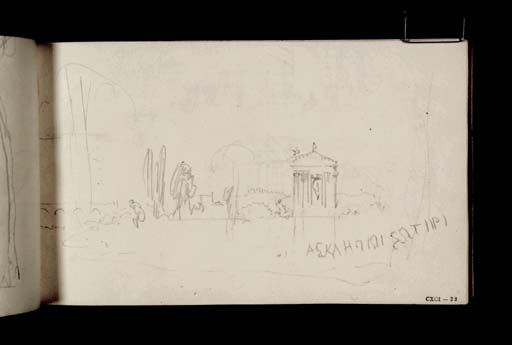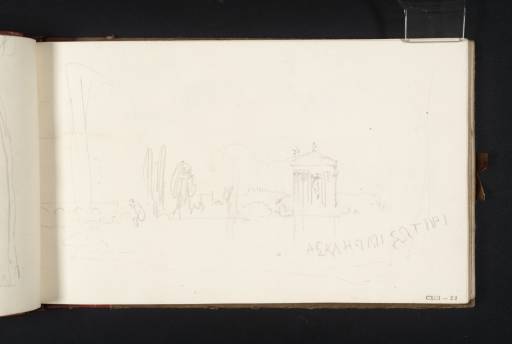Joseph Mallord William Turner The Temple of Aesculapius in the Grounds of Villa Borghese, Rome, with the Greek Inscription from its Façade 1819
Image 1 of 2
-
 Joseph Mallord William Turner, The Temple of Aesculapius in the Grounds of Villa Borghese, Rome, with the Greek Inscription from its Façade 1819
Joseph Mallord William Turner, The Temple of Aesculapius in the Grounds of Villa Borghese, Rome, with the Greek Inscription from its Façade 1819 -
 Joseph Mallord William Turner, The Temple of Aesculapius in the Grounds of Villa Borghese, Rome, with the Greek Inscription from its Façade 1819 (Enhanced image)Enhanced image
Joseph Mallord William Turner, The Temple of Aesculapius in the Grounds of Villa Borghese, Rome, with the Greek Inscription from its Façade 1819 (Enhanced image)Enhanced image
Joseph Mallord William Turner,
The Temple of Aesculapius in the Grounds of Villa Borghese, Rome, with the Greek Inscription from its Façade
1819
Joseph Mallord William Turner 1775–1851
Folio 22 Recto:
The Temple of Aesculapius in the Grounds of Villa Borghese, Rome, with the Greek Inscription from its Façade 1819
D16525
Turner Bequest CXCI 22
Turner Bequest CXCI 22
Pencil on white wove paper, 113 x 189 mm
Inscribed by the artist in pencil ‘¿S¿¿¿¿¿O¿ . SO¿¿¿¿’ bottom right
Stamped in black ‘CXCI 22’ bottom right
Stamped in black ‘CXCI 22’ bottom right
Accepted by the nation as part of the Turner Bequest 1856
References
1909
A.J. Finberg, A Complete Inventory of the Drawings of the Turner Bequest, London 1909, vol.I, p.568, as ‘Do.[Group of trees, with temple]’.
1984
Cecilia Powell, ‘Turner on Classic Ground: His Visits to Central and Southern Italy and Related Paintings and Drawings’, unpublished Ph.D thesis, Courtauld Institute of Art, University of London 1984, p.428, as ‘The Temple of Aesculapius in the grounds of Villa Borghese and the Greek inscription from its façade’.
Cecilia Powell has identified this sketch as a view of the Temple of Aesculapius in the grounds of the Villa Borghese, a large area of parkland north of central Rome, built during the early seventeenth century for Cardinal Scipione Borghese, nephew of Pope Paul V.1 Flaminio Ponzio (circa 1560–1613), the architect who designed the Casino Borghese, also laid out the grounds including a series of formal gardens, an area of natural parkland, an aviary (the Uccelliera), and a scattering of statues, fountains and ancient monuments. The park was further transformed during the late eighteenth and early nineteenth centuries by the building of a wooded lake garden, landscaped in the English manner with neo-classical features, partly designed by the British artist, Jacob More (circa 1740–1793).2 The Temple of Aesculapius (Tempio di Esculapio) is an eighteenth century addition to the grounds. Built in 1786 by Antonio and Mario Asprucci, the building is of Ionic design and houses a statue of the eponymous god.3 Turner’s sketch looks across at the temple from the opposite side of a small lake. In the bottom right-hand corner he has made an accurate transcription of the Greek inscription which runs beneath the frieze across the façade. Further studies from alternate viewpoints can be found on folio 22 verso (D16526).
Turner made a number of quick studies of the Borghese gardens with the various architectural features seen through the trees, see for example the St Peter’s sketchbook (Tate D16267–D16270; Turner Bequest CLXXXVIII 61–63). Other sketches of the grounds can be found on folios 21–21 verso and 23 (D16523–D16524 and D16527).
Nicola Moorby
February 2009
Raymond Keaveney, Views of Rome from the Thomas Ashby Collection in the Vatican Library, exhibition catalogue, Smithsonian Institution, Washington 1988, p.221.
See http://en.villaborghese.it/la_villa/arredi_architettonici__1/tempio_di_esculapio , accessed February 2009.
How to cite
Nicola Moorby, ‘The Temple of Aesculapius in the Grounds of Villa Borghese, Rome, with the Greek Inscription from its Façade 1819 by Joseph Mallord William Turner’, catalogue entry, February 2009, in David Blayney Brown (ed.), J.M.W. Turner: Sketchbooks, Drawings and Watercolours, Tate Research Publication, December 2012, https://www

